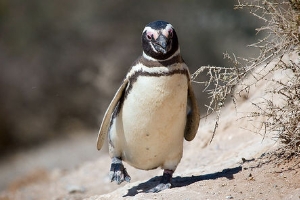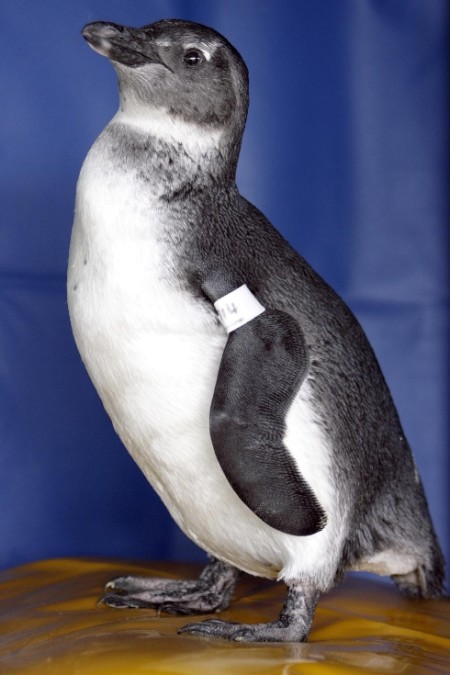 Penguins, like canaries in coal mines, are a leading indicator of climate change and other environmental hazards. Their frozen habitat is getting smaller. A warmer ocean means the migration patterns of fish have changed, so penguins are forced to travel much farther for food. The Magellanic penguins of South America now need to travel 25 miles farther than they did just a decade ago. Overfishing and oil pollution also contribute to the plight of penguins.
Penguins, like canaries in coal mines, are a leading indicator of climate change and other environmental hazards. Their frozen habitat is getting smaller. A warmer ocean means the migration patterns of fish have changed, so penguins are forced to travel much farther for food. The Magellanic penguins of South America now need to travel 25 miles farther than they did just a decade ago. Overfishing and oil pollution also contribute to the plight of penguins.
In honor of Thanksgiving – when we eat another bird – the Washington Post featured a story on a penguin rehabilitation center, the Southern African Foundation for the Conservation of Coastal Birds (SANCCOB). Most of SANCCOB’s rescue efforts focus on birds who suffer from oil spills.
According to researcher Pablo García-Borboroglu: “Penguins are particularly vulnerable to petroleum spills because they swim low in the water, must surface regularly to breathe, do not fly, are less able to detect and avoid petroleum than other seabirds, and often encounter discharges of petroleum when they are at sea. . . . Petroleum pollution has killed thousands of penguins in Africa, Australia and New Zealand, South America, and even Antarctica.”
Why are penguins so special?
Part of the answer, according to the Post, is the adorability factor: “[T]heir eerie similarity to tuxedo-clad waiters, tendency to waddle and well-documented devotion to their partners and offspring.”
“Penguins aren’t that different from people,” explained Dee Boersma, a conservation biologist at the University of Washington at Seattle, who won the prestigious Heinz Award for her lifelong work on penguins. “They have to make a living, provide for their chicks and commute to find food. Walking upright and looking so well-dressed probably helps us identify with them.”
“Seeing a rockhopper penguin dashed by the waves against a boulder with blood coming from its head get up and shake itself off, then trundle to its nest to greet its mate and chick sure impressed me,” [Boersma] said, recalling an incident she witnessed during her research in the Falkland Islands. “What saddens me is that penguins are having a rough time, and some of this is because of how humans are using the world.”
Adopt a penguin
You can adopt a penguin through the South African seabird rehabilitation center. Although you’ll receive a photo of your penguin, a certificate of adoption, and the equivalent of a medical file on your bird, the SANCCOB guarantees that you will not receive further photos or updates. All rehabilitated birds are released back into the wild.
Here’s a sample of the type of photo you’ll receive:
Happy Thanksgiving!
Related posts:
Climate change
Animals
Pets
Sources:
(Links will open in a separate window or tab.)
Julie Eilperin, What makes this bird so special?, Washington Post, November 24, 2009
The Southern African Foundation for the Conservation of Coastal Birds (SANCCOB)
Shaye Woft, Feds Will Face Lawsuit for Denying Penguins Endangered Species Protections, Center for Biological Diversity, October 6, 2009
Mark Henderson, Penguins in peril as food search turns into marathon, The Global Report, February 17-23, 2009
Jesse Cogan, Little Noticed Decline in Penguin Population Signals Dangerous Changes in Oceans, The Cutting Edge, July 7, 2008
Cornelia Dean, A New Twist in Penguins’ Already Uncertain Future, The New York Times, July 1, 2008



Sorry, comments are closed for this post.